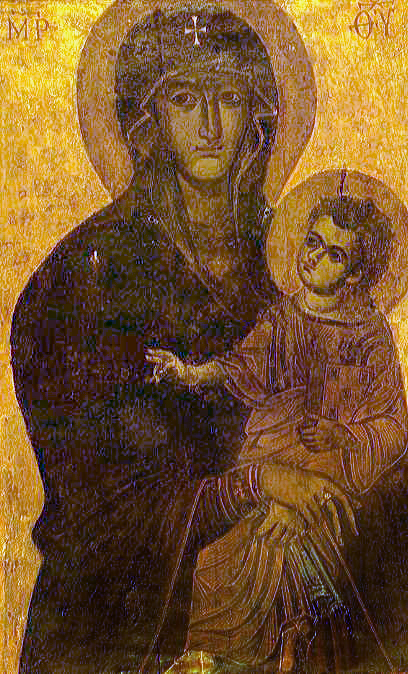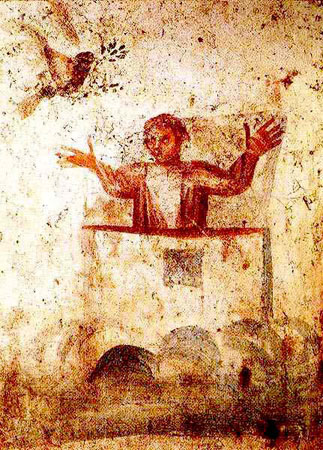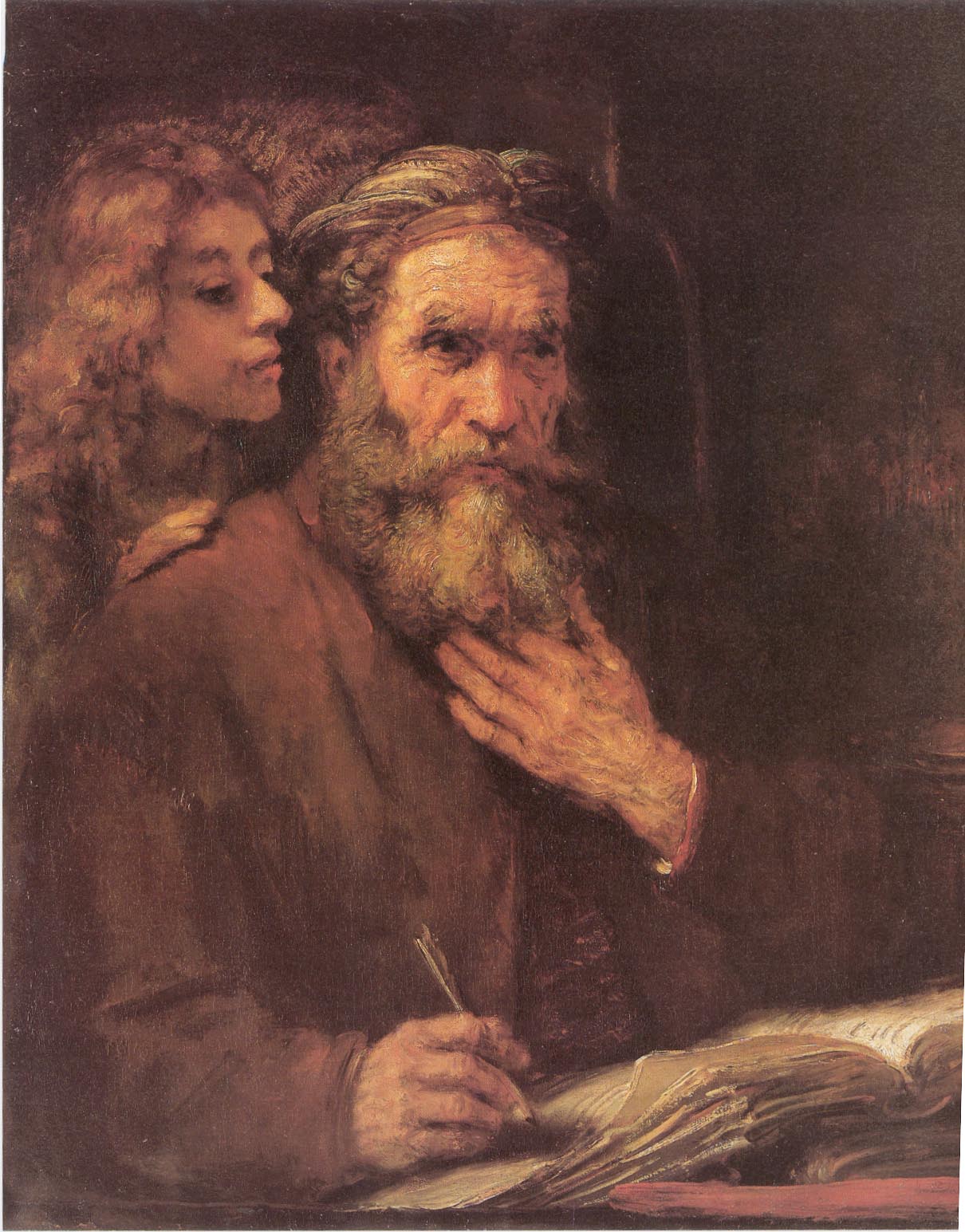|
Catacomb Of Priscilla
The Catacomb of Priscilla is a large archaeological site on the Via Salaria in Rome, Italy, situated in what was a quarry in Roman times. The catacombs extend underground for over seven miles, making them one of Romes most extensive catacombs. it was used for thousands of Christian burials from the late 2nd century through the 4th century. The origin of the catacomb's namesake is highly contested and theorized. In one theory, Priscilla belonged to the Acilii Glabriones family and was the woman patron who donated the site. The family name can be found etched into the hypogeum. The walls also display some of the earliest known frescos of Biblical scenes. Many of these frescos are studied specifically for their portrayal of early Christian women. The modern entrance to the catacombs are on the Via Salaria through the cloister of the monastery of the Benedictines of Priscilla. The Catacombs of Priscilla are divided into three notable areas: a Greek Chapel (Capella Greca), the c ... [...More Info...] [...Related Items...] OR: [Wikipedia] [Google] [Baidu] |
Marian Art In The Catholic Church
Veneration of Mary in the Catholic Church, Mary has been one of the major subjects of Western art for centuries. There is an enormous quantity of Marian art in the Catholic Church, covering both devotional subjects such as the Virgin and Child and a range of narrative subjects from the ''Life of the Virgin'', often arranged in cycles. Most medieval painters, and from the Reformation to about 1800 most from Catholic countries, have produced works, including old masters such as Michelangelo and Botticelli. Marian art forms part of the fabric of Catholic Marian culture through their emotional impact on her veneration. Images such as Our Lady of Guadalupe and the many artistic renditions of it as statues are not simply works of art but are a central element of the daily lives of the Mexican people. Both Miguel Hidalgo, Hidalgo and Emiliano Zapata, Zapata flew Guadalupan flags and depictions of the Virgin of Guadalupe continue to remain a key unifying element in the Mexican nation.''Th ... [...More Info...] [...Related Items...] OR: [Wikipedia] [Google] [Baidu] |
Christianity
Christianity is an Abrahamic monotheistic religion, which states that Jesus in Christianity, Jesus is the Son of God (Christianity), Son of God and Resurrection of Jesus, rose from the dead after his Crucifixion of Jesus, crucifixion, whose coming as the Messiah#Christianity, messiah (Christ (title), Christ) was Old Testament messianic prophecies quoted in the New Testament, prophesied in the Old Testament and chronicled in the New Testament. It is the Major religious groups, world's largest and most widespread religion with over 2.3 billion followers, comprising around 28.8% of the world population. Its adherents, known as Christians, are estimated to make up a majority of the population in Christianity by country, 157 countries and territories. Christianity remains Christian culture, culturally diverse in its Western Christianity, Western and Eastern Christianity, Eastern branches, and doctrinally diverse concerning Justification (theology), justification and the natur ... [...More Info...] [...Related Items...] OR: [Wikipedia] [Google] [Baidu] |
Madonna And Child
In Christian art, a Madonna () is a religious depiction of the Blessed Virgin Mary in a singular form or sometimes accompanied by the Child Jesus. These images are central icons for both the Roman Catholic and Orthodox churches. The word is (archaic). The Madonna and Child type is very prevalent in Christian iconography, divided into many traditional subtypes especially in Eastern Orthodox iconography, often known after the location of a notable icon of the type, such as the '' Theotokos of Vladimir'', '' Agiosoritissa'', '' Blachernitissa'', etc., or descriptive of the depicted posture, as in '' Hodegetria'', '' Eleusa'', etc. The term ''Madonna'' in the sense of "picture or statue of the Virgin Mary" enters English usage in the 17th century, primarily in reference to works of the Italian Renaissance. In an Eastern Orthodox context, such images are typically known as '' Theotokos''. "Madonna" may be generally used of representations of Mary, with or without the infant ... [...More Info...] [...Related Items...] OR: [Wikipedia] [Google] [Baidu] |
Orans
Orans, a loanword from Medieval Latin ''orans'' () translated as "one who is praying or pleading", also orant or orante, as well as lifting up holy hands, is a posture or attitude (art), bodily attitude of prayer, usually standing, with the elbows close to the sides of the body and with the hands outstretched sideways, palms up. The orans posture of prayer has a Scriptural basis in 1 Timothy 2 (): "I desire, then, that in every place the men should pray, lifting up holy hands without anger or argument" (NRSV). It was common in early Christianity and can frequently be seen in early Christian art, being advised by several early Church Fathers, who saw it as "the outline of the cross". In modern times, the orans position is still preserved in Oriental Orthodoxy, as when Coptic Christian believers pray the seven canonical hours of the Agpeya at fixed prayer times. The orans also occurs within parts of the Catholic, Oriental Orthodox, Eastern Orthodox Church, Eastern Orthodox, Luther ... [...More Info...] [...Related Items...] OR: [Wikipedia] [Google] [Baidu] |
Susannah And The Elders
Susanna ( ; ), also called Susanna and the Elders, is a narrative included in the Book of Daniel (as chapter 13) by the Catholic Church, Oriental Orthodox Churches and Eastern Orthodox Churches. It is one of the additions to Daniel, placed in the Apocrypha by Protestants, with Anabaptists, Lutherans, Anglicans and Methodists regarding it as non-canonical but useful for purposes of edification. The text is not included in the Judaism, Jewish Tanakh and is not mentioned in early Jewish literature, although it does appear to have been part of the original Septuagint from the 2nd century BC, and was revised by Theodotion, a Hellenistic Jewish redactor of the Septuagint text (). Summary A fair Hebrews, Hebrew wife named Susanna bathes privately (having sent her attendants away) in her locked and walled garden. Two elders, having previously said goodbye to each other, bump into each other again when they spy on her bathing. The two men realize they both lust for Susanna. When she mak ... [...More Info...] [...Related Items...] OR: [Wikipedia] [Google] [Baidu] |
Fractio Panis
''Fractio Panis'' (English: ''Breaking of Bread'') is the name given to a fresco in the Greek Chapel (''Capella Greca'') in the Catacomb of Priscilla, situated on the Via Salaria Nova in Rome. The fresco depicts seven persons at a table, possibly all women, due to the long skirts (men's wouldn't come past the calf), veil, and all of their upswept hair. The Vatican declares it to be six men and a woman. Like the whole of the decorations of the chapel, the fresco dates from the first half of the 2nd century. The painting is found upon the face of the arch immediately over the altar tomb, upon which the sacrament of the Eucharist was performed. Discovery By chance this particular fresco, having been covered by a thick crust of stalactites, escaped the notice of the early explorers of the catacombs. In 1893, Jesuit art historian Joseph Wilpert, one of a band of young scholars who looked upon De Rossi as their master, arrived at the conclusion that the roof and arches of this chape ... [...More Info...] [...Related Items...] OR: [Wikipedia] [Google] [Baidu] |
New Testament
The New Testament (NT) is the second division of the Christian biblical canon. It discusses the teachings and person of Jesus in Christianity, Jesus, as well as events relating to Christianity in the 1st century, first-century Christianity. The New Testament's background, the first division of the Christian Bible, is called the Old Testament, which is based primarily upon the Hebrew Bible; together they are regarded as Sacred Scripture by Christians. The New Testament is a collection of 27 Christianity, Christian texts written in Koine Greek by various authors, forming the second major division of the Christian Bible. It includes four Gospel, gospels, the Acts of the Apostles, epistles attributed to Paul the Apostle, Paul and other authors, and the Book of Revelation. The Development of the New Testament canon, New Testament canon developed gradually over the first few centuries of Christianity through a complex process of debate, rejection of Heresy, heretical texts, and ... [...More Info...] [...Related Items...] OR: [Wikipedia] [Google] [Baidu] |
Old Testament
The Old Testament (OT) is the first division of the Christian biblical canon, which is based primarily upon the 24 books of the Hebrew Bible, or Tanakh, a collection of ancient religious Hebrew and occasionally Aramaic writings by the Israelites. The second division of Christian Bibles is the New Testament, written in Koine Greek. The Old Testament consists of many distinct books by various authors produced over a period of centuries. Christians traditionally divide the Old Testament into four sections: the first five books or Pentateuch (which corresponds to the Jewish Torah); the history books telling the history of the Israelites, from their conquest of Canaan to their defeat and exile in Babylon; the poetic and wisdom literature, which explore themes of human experience, morality, and divine justice; and the books of the biblical prophets, warning of the consequences of turning away from God. The Old Testament canon differs among Christian denominations. The Ea ... [...More Info...] [...Related Items...] OR: [Wikipedia] [Google] [Baidu] |
Fresco
Fresco ( or frescoes) is a technique of mural painting executed upon freshly laid ("wet") lime plaster. Water is used as the vehicle for the dry-powder pigment to merge with the plaster, and with the setting of the plaster, the painting becomes an integral part of the wall. The word ''fresco'' () is derived from the Italian adjective ''fresco'' meaning "fresh", and may thus be contrasted with fresco-secco or secco mural painting techniques, which are applied to dried plaster, to supplement painting in fresco. The fresco technique has been employed since antiquity and is closely associated with Italian Renaissance painting. The word ''fresco'' is commonly and inaccurately used in English to refer to any wall painting regardless of the plaster technology or binding medium. This, in part, contributes to a misconception that the most geographically and temporally common wall painting technology was the painting into wet lime plaster. Even in apparently '' buon fresco'' technology ... [...More Info...] [...Related Items...] OR: [Wikipedia] [Google] [Baidu] |
Giovanni Battista De Rossi
Giovanni Battista (Carlo) de Rossi (23 February 1822 – 20 September 1894) was an Italian archaeologist, famous even outside his field for rediscovering early Christian catacombs. Life and works Born in Rome, he was the son of Commendatore Camillo Luigi De Rossi and Marianna Marchesa Bruti, his wife, who had two sons, Giovanni and Michele Stefano. Two days after birth Giovanni was baptized in the parish church of Santa Maria sopra Minerva. De Rossi showed an early interest in Christian antiquity. In 1838, in company with his parents, he visited Tuscany, where the innumerable treasures of art completely absorbed his attention. He studied philosophy at the Collegio Romano from 1838 to 1840. He then studied jurisprudence from 1840 to 1844 at the Sapienza, where he was graduated with the degree of doctor utriusque juris ''ad honorem''. [...More Info...] [...Related Items...] OR: [Wikipedia] [Google] [Baidu] |
Agape Feast 05
(; ) is "the highest form of love, charity" and "the love of God for uman beingsand of uman beingsfor God". This is in contrast to , brotherly love, or , self-love, as it embraces a profound sacrificial love that transcends and persists regardless of circumstance. The verb form goes as far back as Homer, translated literally as affection, as in "greet with affection" and "show affection for the dead". Other ancient authors have used forms of the word to denote love of a spouse or family, or affection for a particular activity, in contrast to (an affection of a sexual nature). In the New Testament, refers to the covenant love of God for humans, as well as the human reciprocal love for God; the term necessarily extends to the love of one's fellow human beings. Some contemporary writers have sought to extend the use of into non-religious contexts. The concept of has been widely examined within its Christian context. It has also been considered in the contexts of other relig ... [...More Info...] [...Related Items...] OR: [Wikipedia] [Google] [Baidu] |
Cock (bird)
The chicken (''Gallus gallus domesticus'') is a domesticated subspecies of the red junglefowl (''Gallus gallus''), originally native to Southeast Asia. It was first domesticated around 8,000 years ago and is now one of the most common and widespread domesticated animals in the world. Chickens are primarily kept for their meat and eggs, though they are also kept as pets. As of 2023, the global chicken population exceeds 26.5 billion, with more than 50 billion birds produced annually for consumption. Specialized breeds such as broilers and laying hens have been developed for meat and egg production, respectively. A hen bred for laying can produce over 300 eggs per year. Chickens are social animals with complex vocalizations and behaviors, and feature prominently in folklore, religion, and literature across many societies. Their economic importance makes them a central component of global animal husbandry and agriculture. Nomenclature Terms for chickens include: * ''Bid ... [...More Info...] [...Related Items...] OR: [Wikipedia] [Google] [Baidu] |









